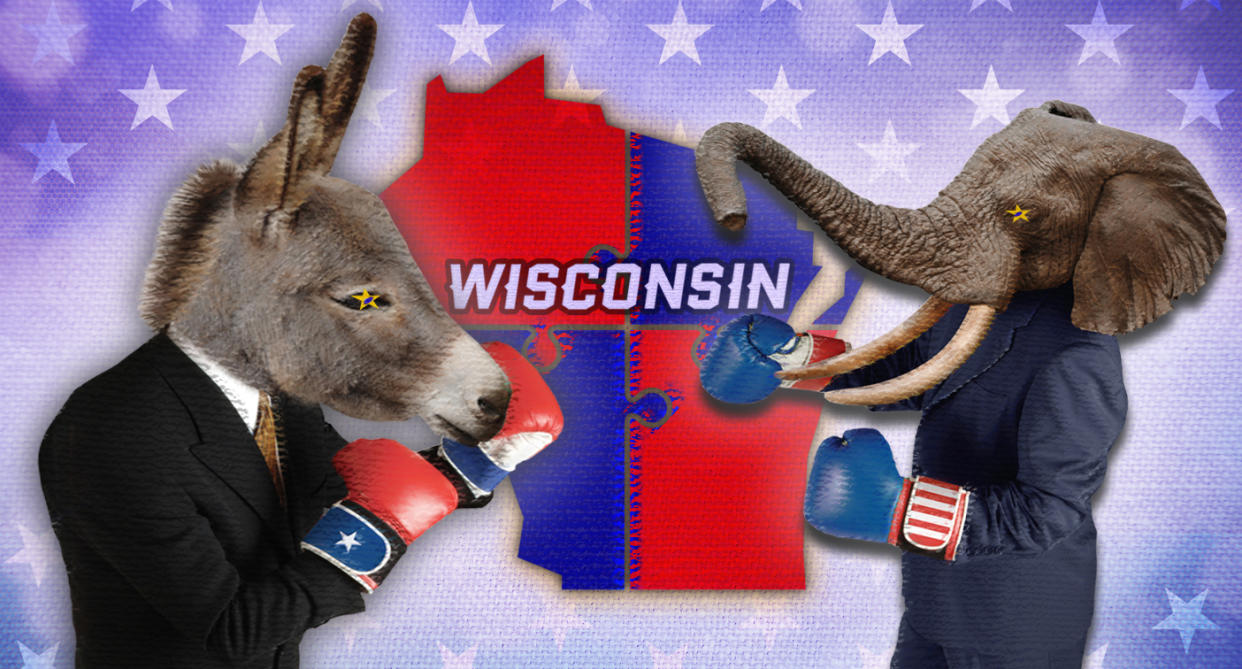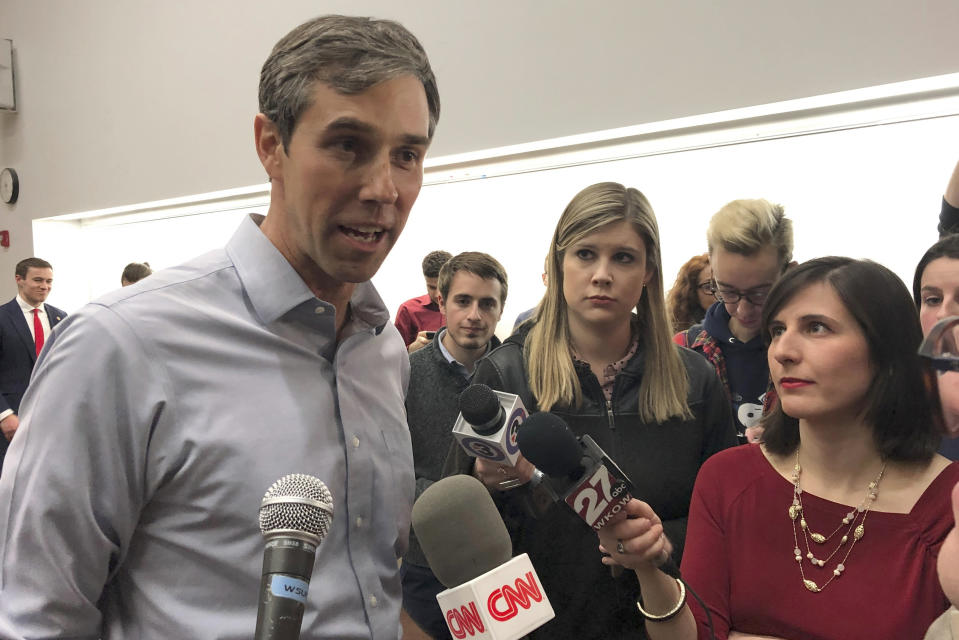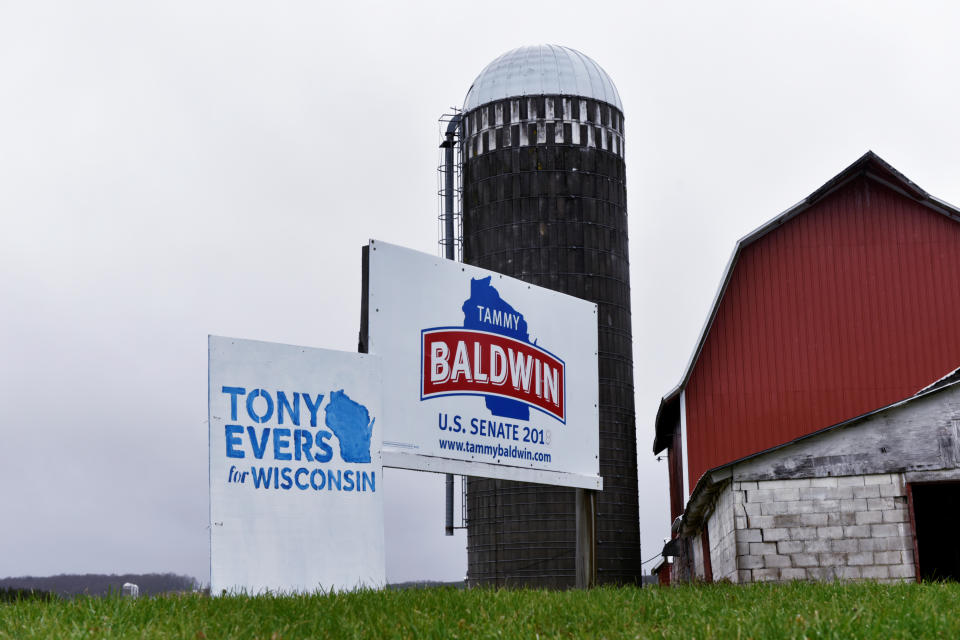Wisconsin could decide 2020. Inside the new Democratic plan to win it back.

Here’s something that should keep Democrats up at night. In 2020, the party’s presidential nominee could recapture the big, historically blue states of Pennsylvania and Michigan, but still lose the Electoral College by two votes, 270-268, if Donald Trump ekes out another narrow victory in Wisconsin — a state he won by just .7 percentage points in 2016.
This isn’t some far-fetched scenario. For Democrats, Pennsylvania and Michigan are riper demographic targets than the Badger State, where the electorate is heavier on (Trump-friendly) non-college-educated whites and lighter on (largely anti-Trump) African-Americans. In the “blue wave” midterm elections of 2018, Dems swept the governorships of Pennsylvania and Michigan by double-digit margins. They flipped Wisconsin by a single percentage point. In Wisconsin’s only statewide contest since then, a conservative state Supreme Court candidate upset his liberal opponent. And when Priorities USA, America’s largest Democratic super-PAC, recently projected the 2020 results, it said that “if the election were held today,” only one state was too close to call: Wisconsin.
“This state is fundamental to any prospect we have of electing a Democrat to the presidency in 2020,” Texas Rep. Beto O’Rourke told reporters during a trip to Madison in March. “We’ve got to show up.”
The other campaigns seem to be coming to the same conclusion. Trump rallied in Green Bay in late April; at the time, his campaign manager, Brad Parscale, tweeted that “Wisconsin is ready for #FourMoreYears.” On Friday, the president will return for a Republican National Committee fundraiser in Milwaukee. Meanwhile, three Democratic candidates (Elizabeth Warren, Bernie Sanders and Julián Castro) will be in town Thursday for a League of United Latin American Citizens event, after which Warren will hold a public town hall — likely the largest Democratic gathering so far this year.

“Elizabeth’s decision to forgo high-dollar fundraisers and call-time means she’s doing the work of building a grassroots movement — state by state, face to face,” says Warren spokeswoman Saloni Sharma. “She’s looking forward to being in Milwaukee to hear from voters about the issues important to them.”
Election Day is still 17 months away; a lot can and will change between now and then. But Wisconsin likely won’t. Over the last decade, Republican activism funded by the Koch brothers has clashed with the state’s deep progressive tradition, tipping the scales in the GOP’s favor and exacerbating polarization between left and right, white and black, urban and rural. The result is perhaps America’s truest bellwether: a state that parallels our divided national politics both in the tightness of its elections and the conflicts that define them.
‘Wisconsin is ground zero’
Last month, the state party elected a new chair, who has a keen sense of the state’s electoral importance. Ben Wikler, a 38-year old Harvard grad, edged out the party’s longtime vice chair, state Rep. David Bowen, at its June convention — even though Wikler had only moved back to Madison, his childhood home, at the end of 2018.
“This is it,” Wikler tells Yahoo News. “This is why I ran for chair. Wisconsin is ground zero for 2020.”
Wikler’s résumé was a big selling point. He attended his first political rally, for then-presidential candidate Jesse Jackson, at age 7. Four years later, he volunteered for his first congressional campaign. In high school he worked for future Sen. Tammy Baldwin; in college he founded the Student Global Aids Campaign and interned for Sen. Russ Feingold. He went on to assist Al Franken with his books and radio show, serve as Sen. Sherrod Brown’s press secretary, direct climate change campaigns for Avaaz, launch his own podcast, and run MoveOn.org’s D.C. operations.
But more important than Wikler’s progressive CV was the recurring theme that ran through it: a winning track record of grassroots activism and organizing, from his ability to secure more public-school funding as a teenager to his successful fight at MoveOn to help prevent Trump Republicans from repealing Obamacare in 2017.
Wikler’s promise — and challenge — is to stop Trump and his allies by bringing those same tactics to Wisconsin.
He has his work cut out for him. As Wisconsin-born journalist Dan Kaufman detailed in his 2018 book, “The Fall of Wisconsin: The Conservative Conquest of a Progressive Bastion and the Future of American Politics,” Republicans took control of the governor’s mansion, the U.S. House delegation, one U.S. Senate seat and both chambers of the state legislature in the 2010 tea party wave and immediately set about transforming the state “from a pioneering beacon of progressive, Democratic politics to the embodiment of that legacy’s national unraveling.” In truth, Wisconsin’s proud progressive era — think Robert La Follette, workers’ compensation, unemployment insurance, state income tax, and so on — was already in the past by then. But with a flood of anti-union and Koch brothers money, coupled with a compliant “populist” figurehead in the form of GOP Gov. Scott Walker, conservatives immediately set about entrenching their politics and power by smashing organized labor, slashing government services, loosening environmental protections, restricting access to voting and gerrymandering the state so aggressively that even when Democrats won 53 percent of assembly votes in 2018, Republicans still wound up with 64 percent of the seats.

Despite that lopsided outcome, last year’s midterms were actually an encouraging affair for Wisconsin Dems. Trump’s net approval rating in the state, which started out positive, plummeted by 19 percentage points since he took office. The backlash registered in November. Sen. Baldwin won reelection by 11 points, and Democratic educator Tony Evers narrowly defeated Walker. In fact, Democrats swept all seven statewide races, including lieutenant governor, attorney general, secretary of state, and treasurer, and even picked up Walker’s old assembly seat.
Democrats continue to enjoy a polling advantage today; the most recent nonpartisan Wisconsin poll shows every single major Democratic candidate outpacing Trump in a head-to-head matchup. In a Marquette Law School poll from early April, 46 percent of respondents said that they would definitely vote against Trump if the election were held today, compared to 28 percent who would definitely vote for him.
But Wikler and others have learned to be skeptical. In 2018, the final polling average showed Evers 5 points ahead of Walker; two years earlier, Hillary Clinton led Trump by 6.5.
More recently, internal Republican polling showed the Democrats’ preferred state Supreme Court candidate, Judge Lisa Neubauer, leading her controversial conservative opponent, Judge Brian Hagedorn, by 8 points a week before Election Day. Then came $1.2 million from the Republican State Leadership Committee, more than a million text messages to low-propensity GOP voters, a conservative talk-radio blitz featuring former Gov. Walker and a barrage of mailers equating Hagedorn with Trump and Brett Kavanaugh, the president’s embattled Supreme Court nominee.
When the ballots were counted, Neubauer came away with 45,000 more votes in last year’s Supreme Court election than the liberal candidate, who breezed to victory by 11 points. But Hagedorn won 160,000 more votes than his 2018 counterpart — and 6,000 more than Neubauer.
“That race illustrated that there’s this intense polarization and interest on both sides,” Wikler says. “If there was any doubt that we can’t take anything for granted, it was vaporized after that.”

So how will Wikler & Co. ensure that the same thing doesn’t happen in 2020?
First, by out-organizing the opposition. “Given how razor-close these races have been, there’s an overwhelming chance 2020 will be won or lost based on field organizing at the end,” Wikler says. “That informs our battle plan. Unlike almost anywhere else in the country, we’re building the ground game through the state party — starting yesterday.”
The model is Obama 2008, with its infrastructure of paid field organizers, neighborhood teams and local volunteers. The field program started in the spring of 2017, before Wikler’s time, and Wisconsin Democrats now have 11 field organizers on staff; in 2018, their teams knocked on 80 percent more doors than in 2016, defying the usual decline in activity from a general-election cycle to a midterm. “It was a huge part of how we defeated Walker,” Wikler says.
To defeat Trump, the plan is to “double down on organizing in communities of color and rural communities — including where they overlap.” If Democrats can reduce Trump’s margins by 10 points in rural Wisconsin, Wikler estimates, they’ll win; if they can “help organize Latino and African-American and young and Native American voters,” they’ll win big (and likely prevent Republicans from picking up the three state legislative seats they need for a veto-proof majority, which would allow them to dominate the post-2020 redistricting process). Helping on that front will be new state party vice chair Felesia Martin, one of former President Barack Obama’s original Wisconsin organizers and co-chair of his 2012 campaign in the state.
Which leads to the second part of Wikler’s strategy: issues. The broader Democratic Party is currently debating whether the best way to win in 2020 is by reaching out to white working-class voters who supported Obama before they backed Trump, or by inspiring and mobilizing base voters who either stayed home in 2016 or cast ballots for third-party candidates. Wikler thinks this is a false choice. “In Wisconsin, there are progressives and conservatives,” he says. “But most of the voters who don’t fit into one of those two categories aren’t ‘centrist.’ They’re conflicted. That might mean they believe in their bones in health care for everyone and the right of workers to organize — while also carrying an NRA card. The question then becomes which of their values is most salient on Election Day.”
The Democratic Party’s “core challenge,” Wikler explains, is to “fight the election on ground where Democrats have tremendous strength and public support” — and to start early. Right now that means sending volunteers to knock on doors in Republican districts to talk about the state GOP’s current effort to block Gov. Evers from expanding Medicaid — an expansion that 70 percent of Wisconsinites favor. In 2020, it might mean “health care, public education, basic infrastructure, clean water — all issues on which Democrats have an overwhelming advantage in the suburbs, the cities and even the rural areas.” The key, Wikler adds, is “not just showing up three months before the election, but partnering with community leaders and other organizations to build relationships and shape the terrain a year and a half out, between elections.”

Technology will play a part as well. At MoveOn, Wikler saw firsthand the political power of text messaging and other mobile applications. Yet organizers in Wisconsin still use paper packets when knocking on doors, and there’s no statewide SMS apparatus in place. Wikler intends to change that, adopting MoveOn’s cheaper, open-source version of Hustle — the political, peer-to-peer texting platform — and making it available to organizers and officials for free. “We’re ready for an upgrade,” he says.
Between now and next November, there will be two major moments for Wisconsin Democrats to build their organizing capacity and test their tactics. The first will come on April 7. That’s the day of the Democratic presidential primary; it’s also the day Wisconsites will elect mayors, school board members, county board members and so on. With no real primary contest on the Republican side, Democratic turnout should reach record highs for a spring election — which means, Wikler says, there’s “a huge opportunity for us to recruit and support an array of amazing, diverse candidates to run for local office in every part of the state. Even where Republicans are used to winning.”
The second moment will come later, during July 13-16. That’s when the entire Democratic Party will descend on Milwaukee for its national convention. Wikler acknowledges that hosting a convention doesn’t always “lead to victory” in a given state; just look at what happened in Pennsylvania in 2016. But it does mean that “if Democrats organize the way we’re planning to organize, we’re going to come out of there with thousands of new, fired-up volunteers who are trained and ready to organize, day in and day out.”

It is, of course, impossible to predict the dynamics that will ultimately define 2020 in Wisconsin. The Democratic nomination is far from decided. Trump will do everything in his power to divide and distract. And issues will come and go and change along the way; for instance, nobody seems to know whether the Foxconn plant that Trump touted as the “eighth wonder of the world” will deliver the blue-collar jobs Republicans promised — or fall far short of those goals.
Recall the perfect storm that struck Wisconsin in 2016: Voter ID laws deterred as many as 45,000 registered voters from casting ballots. The black voter turnout rate dropped from 79 percent in 2012 to 47 percent four years later — the lowest in the state’s recorded history. The Democratic nominee, Clinton, canceled her only scheduled general-election visit to Wisconsin and opened roughly half as many field offices there as Obama. Then the Republican nominee, Trump, won the state by 22,748 votes.
With that in mind, Wikler sees it as his mission to leave as little as possible to luck. “Our goal is to create a campaign-in-waiting for the next Democratic nominee, so he or she doesn’t have to start from scratch in July,” he says. “There is a very real chance that whoever wins Wisconsin becomes president.”
Read more from Yahoo News:
GOP whip Scalise cites Trump accuser’s ‘bizarre’ CNN interview in doubting her account
Pentagon secretly struck back against Iranian cyberspies targeting U.S. ships
'Great Replacement' ideology is spreading hate in U.S. and across the globe
How Europe's smallest nations are battling Russia's cyberattacks





